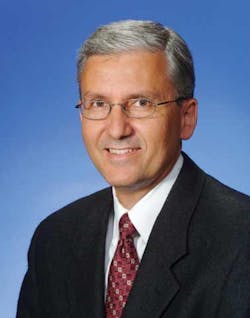"If I had to break it down, I’d say we’re pursuing two key objectives, which is to serve the end user and also serve the dealer,” says Marc Laferriere, vice president of marketing for Michelin Americas Truck Tires, whose Michelin Retread Technologies Inc. (MRTI) arm signed several big retreaders last year.
Greensboro, N.C.-based Snider Tire Inc., one of the country’s largest retreaders, joined MRTI last spring. Snider, which had been a long-time Bandag retreader, opened a new MRTI plant in Houston this past September.
MRTI also signed Edenton, N.C.-based Colony Tire Corp., which converted four Bandag shops to the Michelin process.
Will there be more converts to MRTI this year? Maybe.
“Our goal is not to expand forever and ever in terms of numbers of clients,” says Laferriere. “We’re very close to the total number of plants that we were targeting for Mexico, Canada and the U.S.” MRTI currently has 80 plants in the U.S.
“Our business model is still based on relatively large plants that are very efficient in terms of process, turnaround time and production costs. We also need to be efficient in terms of logistics. We need to have those large plants strategically located so we can serve key markets.”
In this interview, Laferriere discusses MRTI’s business model, Michelin’s efforts to ensure that its retread technology mirrors its new truck tire technology, and more.
[PAGEBREAK]
CTD: You said MRTI’s business model is based on large plants. What’s your definition of a large plant?
Laferriere: It has to (process) more than 20,000 or 30,000 tires a year. We have a complementary business model between MRTI and Oliver (MRTI acquired Oliver Rubber Co. from Cooper Tire & Rubber Co. in 2007. - Ed.) A smaller plant that’s in a more rural area is going to be a better fit for the Oliver license and a larger plant that’s in a bigger metropolitan area will be a better fit for MRTI.
CTD: If you’re an MRTI retreader, can you also use the Oliver process, or are the systems mutually exclusive?
Laferriere: There are certain treads at Oliver that are made available to the MRTI franchises, but it’s limited in terms of volume.
CTD: Does Michelin require MRTI retreaders to sell new Michelin or BFGoodrich brand truck tires?
Laferriere: We don’t have an exclusivity requirement on new tires. What I can tell you is our product plan is going to be very active, and the retread plan is in lock-step with our new truck tire plan. What you’re going to see from Michelin in the next couple of years is parallel or almost simultaneous introductions of new tire technologies and the retread technologies to go along with it.
What we’ve found is that there is a tremendous buzz associated with the introduction of a new product. But the customer wants to know, “What am I going to do on the retread side?”
Right now, if we give them sort of a one-generation-behind solution on retreads, they find that they kind of sacrifice some technology. What we want to do is capitalize on the new technology (in Michelin truck tires) and do it very quickly on the retread side.
We’re going to work on more introductions of new products. You’ll see some additional dimensions, (such as) wider treads in some of our more popular designs.
[PAGEBREAK]CTD: What’s your take on the general state of the U.S. retread market?
Laferriere: We’re planning for the market to have a bit of a bounce-back on the new tire side. The retread business has been a lot more stable. However, we’re bracing ourselves for the fact that we’re now entering a third year of record low influx of new tires at OE and a slow replacement market.
If the market picks up during the second half of the year, I think we’re going to see a lot of customers re-equip some trucks they’ve parked over the last 12 months.
Laferriere believes it will take a couple of years for the retread market to rebound to 2005-06 levels. “For one thing, we need OE to go back up and inject some casings” into the market. “And we need replacement to go back up and inject some casings. Then I think we’ll be back to the 14-million unit range. We’re not close to it now.” ■



